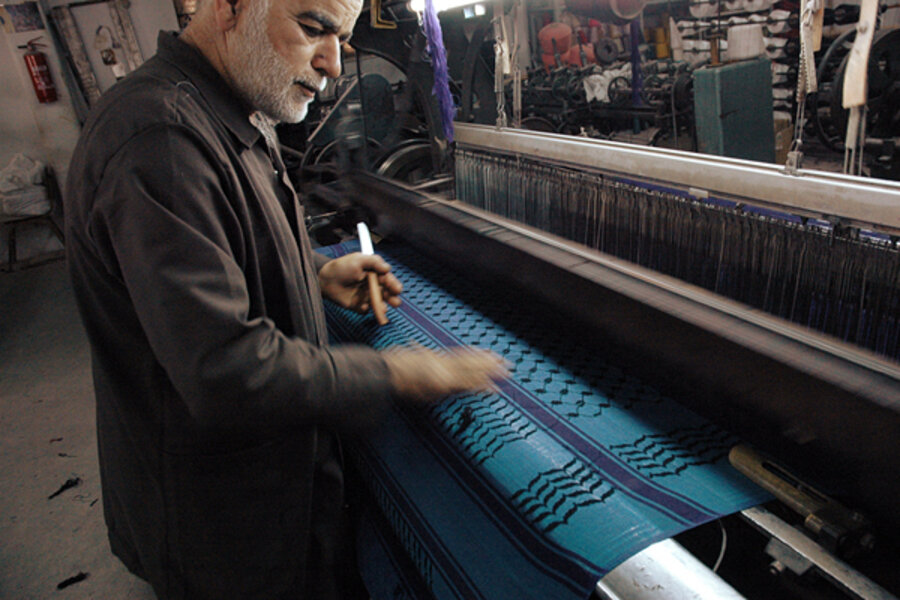In West Bank, one family's stand against made-in-China keffiyehs
Loading...
| Hebron, West Bank
No one told the looms at the Hirbawi Keffiyeh factory that business is slow in the West Bank.
Some are as old as the factory, bearing the inscription “1961.” But they still churn out the fabric for traditional Palestinian head scarves, and at a deafening pace.
This is the only Palestinian factory that still produces keffiyehs, popularized by the late Yasser Arafat as a symbol of the Palestinian national struggle. All other keffiyehs sold in the West Bank these days are made in China, which many blame on the Palestinian Authority’s liberalization of trade policies over the past two decades.
“This is a national product that should be protected by the government, not sabotaged by the government,” says Abdulaziz Karaki, one of only two workers still employed by the Hirbawi family, which had as many as 15 employees in the 1990s.
After years of lobbying by small producers such as the Hirbawis, the Palestinian Authority (PA) last week announced that it had introduced new tariffs on imports that directly compete with Palestinian goods. Among them are not only textiles such as keffiyehs, but also shoes, leather goods, and furniture.
The move goes against nearly 20 years of market liberalization in the West Bank, which mirrored the Israeli trend of lowering barriers for international goods. It represents a “revolutionary” step by the PA to use the limited tools at its disposal to develop the West Bank economy, says economist Raja Khalidi of the United Nations Conference on Trade and Development (UNCTAD).
“This is the first time that they decided to reverse and go in the opposite direction [from Israel] because of their own national development and industrial interests,” says Dr. Khalidi, who attributes the move to increasingly intolerable pressures on the PA economy.
Manufacturing
Indeed, the influx of imports has taken a serious toll on Palestinian manufacturing jobs.
For example, the number of shoe and leather factories in the West Bank was roughly halved from 2000 to 2010, and those remaining are only working at 20 percent capacity on average. The number of employees in those factories dropped even more sharply, from 40,000 to 1,997 during the same period, according to PA Ministry of Finance statistics.
In Hebron alone, only a third as many factories remain, while textile factories were nearly all wiped out, according to Hebron Chamber of Commerce CEO Jawwad Sayyed al-Herbawi.
Mr. Karaki, in the keffiyeh factory, says that when his fellow workers started losing jobs, he blamed first the PA and second those businessmen who had decided to start importing cheap goods from China.
But both the government and local tradesmen are affected by Israeli decisions as well. Many Israeli businesses used to subcontract work to Hebron manufacturers, but have since sought factories elsewhere – such as Turkey. And while Israeli security restrictions, including internal checkpoints, have eased somewhat since the Second Intifada petered out around 2005, they still add costs and sometimes deter customers and investors due to the unpredictability of business.
Economic collapse
Under the British Mandate, the ratio of Arabs to Jews in Palestine was about 60/40 and their shares of the local economy were roughly inverse, with Jews producing about 60 percent of GDP. Today, the proportion of Arabs (in Israel, the West Bank, and Gaza) has dropped somewhat to just under half, but the ratio of Arab-Jewish GDP has plummeted, with the Arab share of the local economy now down to 12 percent, according to Khalidi. (Editor's note: A previous version of the story misstated the Arab percentage of GDP.)
For the past two decades, trade between Israel and the Palestinians has been governed by the 1994 Paris Protocol, signed as part of the Oslo peace accords. The Palestinian Authority, formed the same year, initially welcomed the agreement because it enabled them to collect trade tax revenues for the first time.
But with strict rules binding the PA economy to Israel’s and reliant on Israel's currency and interest rate polices, the PA was left with few levers to help the economy flourish.
In the past year, the PA faced one of its worst economic crises of its two-decade existence. It began introducing a series of unpopular measures including a hike in the value-added tax and fuel prices, which precipitated intense protests in September 2012.
In mid-April, the PA decided to impose tariffs of up to 35 percent on products traditionally made in the West Bank, such as shoes, leather, textiles, furniture, and aluminum. In practice, the tariffs on some 200-plus items are more in the range of 12 to 24 percent. But they still stand in stark contrast with an Israeli decision March 1 to drop such trade tariffs altogether.
“This is the first time the Palestinians have used something they have in this nearly empty toolbox [the Paris Protocol], which they could have done at any point in the 1990s or 2000s,” says Khalidi.
Good news?
Some Palestinian producers have been calling the Ministry of Finance in glee over the decision, saying they’re going to reopen their factories. But others are more cautious, and concerns remain that Chinese goods could still be imported without any tariffs into Israel and then smuggled into the West Bank.
“It has not been implemented yet so I don’t take it seriously,” says Izzat Hirbawi, one of three brothers that run the keffiyeh factory for their octogenarian father.
Instead, they’ve taken their own initiative to improve business. In the past five years, they started introducing new colors into the traditional white-and-black keffiyeh market. Spools of brilliant turquoise, violet, and gold thread line the cubbyholes along one wall of the factory, where Mr. Hirbawi designs new patterns.
He credits that innovation with boosting sales to more than twice what they were in 2000 and the fact that he soon plans to have all his looms running again – and an extra worker on the floor.
Other Hebron entrepreneurs have adapted by opening their own factories in China, which make paper goods, shoes, leather, and household goods like cups and glasses.
Mr. Herbawi of the Chamber of Commerce says he personally knows 10 such businessmen, but that there are many others. Enough, apparently, that there is reportedly even a street in Shenzhen, China, named Khalil, the Arabic name for Hebron. And among some of Hebron’s newer, fancier homes can be seen the influence of Chinese architecture – not least of all pagoda-style roofs and balconies.
Herbawi says local customers are starting to think twice about the supposedly good value of Chinese goods.
“People are starting to realize that low quality and low prices are costing them much higher than what they could have paid for a local product,” says Herbawi, who advocates some sort of standards commission rather than tariffs as the best solution. “They are buying a pair of shoes for 20 to 40 NIS ($6 to $11) and spending a couple of months and then throwing it away and buying another one.”
While some are motivated by pocketbook considerations, however, others buy “Made in Palestine” for more patriotic reasons.
“I don’t want Chinese-made stuff,” says Ismail Wazwaz, a Hebron native who dropped by the keffiyeh factory on a visit home from his job in Paris. “I prefer to pay for my country.”






